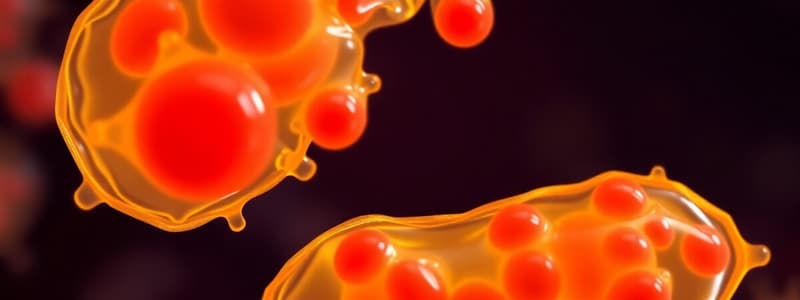Podcast
Questions and Answers
What is the primary characteristic of lysosomal storage diseases?
What is the primary characteristic of lysosomal storage diseases?
- They only affect the liver and kidneys.
- They are exclusively inherited in an X-linked manner.
- They are caused by mutations in lysosomal enzymes. (correct)
- They result from environmental toxins.
Which enzyme is defective in Gaucher's disease?
Which enzyme is defective in Gaucher's disease?
- Galactocerebrosidase
- Sphingomyelinase
- Glucocerebrosidase (correct)
- Hexosaminidase A
In Niemann-Pick disease, which substances accumulate in the body?
In Niemann-Pick disease, which substances accumulate in the body?
- Glucose and fructose
- Sucrose and maltose
- Sphingomyelin and cholesterol (correct)
- Galactose and lactose
Which statement is true regarding the inheritance pattern of most lysosomal storage diseases?
Which statement is true regarding the inheritance pattern of most lysosomal storage diseases?
What type of accumulation occurs in Tay-Sachs disease due to the enzymatic defect?
What type of accumulation occurs in Tay-Sachs disease due to the enzymatic defect?
What is the primary function of lysosomes in cells?
What is the primary function of lysosomes in cells?
Which type of cell is rich in lysosomes due to its phagocytic activity?
Which type of cell is rich in lysosomes due to its phagocytic activity?
Lysosomal enzymes are most active at which pH range?
Lysosomal enzymes are most active at which pH range?
What is NOT found in lysosomes?
What is NOT found in lysosomes?
What mechanism do lysosomes use to maintain their acidic internal environment?
What mechanism do lysosomes use to maintain their acidic internal environment?
Approximately how many lysosomes are typically found in each cell?
Approximately how many lysosomes are typically found in each cell?
What is the initial site of synthesis for lysosomal hydrolases?
What is the initial site of synthesis for lysosomal hydrolases?
Which of the following enzymes is responsible for nucleic acid degradation in lysosomes?
Which of the following enzymes is responsible for nucleic acid degradation in lysosomes?
Which of the following statements about lysosomes is true?
Which of the following statements about lysosomes is true?
Which marker is added to lysosomal hydrolases in the cis Golgi network?
Which marker is added to lysosomal hydrolases in the cis Golgi network?
Which of the following is NOT a pathway that delivers materials to lysosomes?
Which of the following is NOT a pathway that delivers materials to lysosomes?
What are residual bodies that accumulate in aging cells referred to as?
What are residual bodies that accumulate in aging cells referred to as?
What is one of the defense mechanisms mediated by lysosomes?
What is one of the defense mechanisms mediated by lysosomes?
Which end product of lysosomal digestion comes from proteins?
Which end product of lysosomal digestion comes from proteins?
How do exceptionally durable materials remain after lysosomal digestion?
How do exceptionally durable materials remain after lysosomal digestion?
What is one function of lysosomal hydrolases?
What is one function of lysosomal hydrolases?
What is the primary function of lysosomal hydrolases being active at acidic pH?
What is the primary function of lysosomal hydrolases being active at acidic pH?
Which characteristic of lysosomal membrane proteins protects them from degradation?
Which characteristic of lysosomal membrane proteins protects them from degradation?
What is the role of mannose-6-phosphate (M6P) in lysosomal enzyme targeting?
What is the role of mannose-6-phosphate (M6P) in lysosomal enzyme targeting?
What happens to lysosomal enzymes once they reach the acidic environment of the lysosome?
What happens to lysosomal enzymes once they reach the acidic environment of the lysosome?
What type of vesicles fuse with primary lysosomes to form secondary lysosomes?
What type of vesicles fuse with primary lysosomes to form secondary lysosomes?
Which aspect of M6P receptors allows for their recycling in the trans-Golgi network?
Which aspect of M6P receptors allows for their recycling in the trans-Golgi network?
What form does lysosomal enzymes take in transport vesicles before being delivered to lysosomes?
What form does lysosomal enzymes take in transport vesicles before being delivered to lysosomes?
What is the unique feature of lysosomal membranes that aids in their function?
What is the unique feature of lysosomal membranes that aids in their function?
Flashcards
Lysosomes Function
Lysosomes Function
Intracellular digestion of macromolecules using hydrolytic enzymes.
Lysosome Structure
Lysosome Structure
Membrane-enclosed organelles filled with enzymes for macromolecule digestion.
Lysosome Location
Lysosome Location
Found in most animal cells; absent in red blood cells; plant cells have related vacuoles.
Lysosomal Enzymes
Lysosomal Enzymes
Signup and view all the flashcards
Lysosome pH
Lysosome pH
Signup and view all the flashcards
Lysosome Size
Lysosome Size
Signup and view all the flashcards
Lysosomal Acid Hydrolases
Lysosomal Acid Hydrolases
Signup and view all the flashcards
Lysosome Acidification
Lysosome Acidification
Signup and view all the flashcards
Lysosome function
Lysosome function
Signup and view all the flashcards
Lysosomal pH
Lysosomal pH
Signup and view all the flashcards
Lysosomal membrane proteins
Lysosomal membrane proteins
Signup and view all the flashcards
Lysosomal enzymes
Lysosomal enzymes
Signup and view all the flashcards
Primary Lysosomes
Primary Lysosomes
Signup and view all the flashcards
Mannose-6-phosphate (M6P)
Mannose-6-phosphate (M6P)
Signup and view all the flashcards
M6P Receptor Proteins (recycling)
M6P Receptor Proteins (recycling)
Signup and view all the flashcards
Secondary Lysosomes
Secondary Lysosomes
Signup and view all the flashcards
Lysosomal Hydrolases Synthesis Location
Lysosomal Hydrolases Synthesis Location
Signup and view all the flashcards
M6P Receptor Function
M6P Receptor Function
Signup and view all the flashcards
Lysosome Delivery Pathways
Lysosome Delivery Pathways
Signup and view all the flashcards
Lysosomal Waste Products
Lysosomal Waste Products
Signup and view all the flashcards
Lipofuscin Formation
Lipofuscin Formation
Signup and view all the flashcards
End Products of Lysosomal Digestion
End Products of Lysosomal Digestion
Signup and view all the flashcards
Lysosome Exocytosis
Lysosome Exocytosis
Signup and view all the flashcards
Lysosomal Hydrolase Transport
Lysosomal Hydrolase Transport
Signup and view all the flashcards
Lysosomal Storage Diseases
Lysosomal Storage Diseases
Signup and view all the flashcards
Gaucher's Disease
Gaucher's Disease
Signup and view all the flashcards
Niemann-Pick Disease
Niemann-Pick Disease
Signup and view all the flashcards
Tay-Sachs Disease
Tay-Sachs Disease
Signup and view all the flashcards
Lysosomal Enzyme Defects
Lysosomal Enzyme Defects
Signup and view all the flashcards
Study Notes
Lysosomes
- Lysosomes are membrane-enclosed organelles
- They are responsible for intracellular digestion
- They are dense rounded bodies
- Approximately 300 lysosomes are found in each cell
- Their size and shape vary according to the material being digested
- Lysosomes are 0.5-1 µm in diameter
- They are abundant in cells specializing in phagocytosis, such as macrophages and neutrophils
- Found in all animal cells except erythrocytes
- Plant cells lack lysosomes but contain large vacuoles related to lysosomes which contain hydrolytic enzymes
Lysosomal Enzymes
- Lysosomes contain about 60 degradative enzymes that hydrolyze proteins, DNA, RNA, polysaccharides, and lipids
- Lysosomal acid hydrolases include proteases, nucleases, glycosidases, lipases, phosphatases, and sulphatases
- These enzymes are active at an acidic pH (pH 4.5-5.0), but not in the neutral pH (pH 7.2) of the cytoplasm.
Lysosomal Functions
-
Lysosomes maintain an acidic pH by pumping H+ ions into lysosomes using the energy from ATP hydrolysis
-
This results in an acidic pH inside the lysosome that is critical for keeping the enzymes active
-
The lysosomal membrane includes a proton pump with ATPase that transports protons into the lysosome.
-
The acidic pH provides double protection against uncontrolled digestion in the cytosol
-
Lysosomal proteins are unusually glycosylated at their noncytosolic surface
-
They form a glycocalyx layer, which protects lysosomal membranes from acid hydrolases
-
Lysosomal membranes contain transport proteins for carrying final digestion products like amino acids, sugars, and nucleotides into the cytosol.
-
Lysosomal enzymes are resistant to proteases and peptidases
-
Glycosylation of lysosomal proteins protects them from degradation
Formation and Types of Lysosomes
- Vesicles containing lysosomes enzymes are called primary lysosomes
- Primary lysosomes fuse with vesicles containing material to be digested (late endosomes) to form secondary lysosomes.
- Primary lysosomes contain inactive digestive enzymes in granules
- They do not undergo digestion, and cannot eliminate content outside the cell
- Secondary lysosomes contain active digestive enzymes
- They undergo digestion
- They can eliminate content outside their cell
Lysosomal Proteins and Recognition
- Lysosomal proteins carry a unique marker, mannose-6-phosphate (M6P)
- In the cis-Golgi network, M6P markers are added to the N-linked oligosaccharides of lysosomal enzymes
- The Golgi complex packages hydrolytic lysosomal enzymes to form primary lysosomes
- M6P receptors in the trans-Golgi network recognize the M6P markers on lysosomal hydrolases
- Receptors bind and help package the hydrolases into coated transport vesicles that fuse with lysosomes
- Acidic pH in the lysosome causes the lysosomal enzymes to dissociate from the M6P receptors, releasing the enzymes into the lumen
- M6P receptors then return to the trans Golgi to be reused
Lysosomal Functions - continued
- Lysosomes mediate a variety of digestive functions
- Breakdown of intra- and extracellular materials
- Production of nutrients from digested material
- Destruction of phagocytosed microorganisms (defense mechanism)
Pathways for Delivering Materials to Lysosomes
- Digestion of macromolecules from extracellular fluid by endocytosis
- Digestion of material taken up by phagocytosis (defense against invading bacteria)
- Digestion of cell's own components (autophagy)
End Products of Lysosomal Digestion
- End products of lysosomal digestion include amino acids, fatty acids glycerol, cholesterol, monosaccharides, nucleotides, and undigested cellular waste products (e.g., lipofuscin)
- These final products are transported to the cytosol.
- Material that cannot be digested (resistant or slowly digestible residues) remain in the vesicle.
- The vesicle is released by exocytosis or forms a membrane-enclosed residual body.
Residual Bodies and Lysosomal Diseases
- Residual bodies are vesicles containing indigestible materials
- Lipofuscin is a type of residual body that accumulates in aging nerve, heart, and liver cells
- The accumulation leads to 'brown degeneration'
Lysosomal Diseases
- Lysosomal diseases arise from defects in lysosomal enzymes
- Undigested substrates accumulate and disrupt cellular functions
- There are more than 30 known lysosomal storage diseases
- These disorders are often inherited in an autosomal recessive pattern
Studying That Suits You
Use AI to generate personalized quizzes and flashcards to suit your learning preferences.



